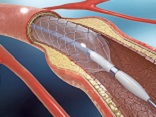Effect of Showing Angiograms to Patients After Elective Percutaneous Coronary Intervention on Anxiety and Illness Perception: A Randomized, Blinded, Controlled Clinical Trial
DOI:
https://doi.org/10.31661/gmj.v8i.1556Keywords:
Coronary Heart Disease, Percutaneous Coronary Interventions, Anxiety, QuestionnairesAbstract
Background: As an invasive modality, a coronary angioplasty may cause a great deal of anxiety in patients and affect their mental health and general well-being. Accordingly, we sought to assess whether showing patients the video of their elective percutaneous coronary intervention (angiogram) could affect their illness perception and anxiety level. Materials and Methods: In this randomized clinical trial, the patients undergoing angioplasty, were randomly divided into two groups of 30 patients. Angiograms were shown only to the intervention group postprocedurally. A checklist comprising demographic data and clinical presentations as well as the Beck anxiety questionnaire and the Brief Illness Perception Questionnaire (BIPQ) was completed for each patient immediately after the intervention and one month later. The differences in the patients’ anxiety level and illness perception were analyzed. Results: In the intervention group, the mean anxiety score before and after watching the angiograms was 34.26 ± 8.1 and 24.4 ± 8.56, respectively. While in the control group, the score before and after angioplasty was 34.46 ± 9.34 and 26.6 ± 9.44, respectively. Thus, watching angiograms led to a significant decrease in the anxiety score in the intervention group, whereas there was no such difference in the control group. There was also a considerable difference in the anxiety score between the two groups. Further, there was a significant decrease in the BIPQ score of the intervention group after watching the angioplasty videos. Conclusion: Educating cardiovascular patients about diagnostic and therapeutic procedures may confer such good outcomes as alleviated anxiety, enhanced satisfaction, and ultimately, fewer anxiety-related complications. [GMJ.2019;8:e1556]
References
Nichols M, Townsend N, Scarborough P, Rayner M. Cardiovascular disease in Europe 2014: epidemiological update. Eur Heart J. 2014; 35(42): 2950-9 https://doi.org/10.1093/eurheartj/ehu299PMid:25139896 Townsend N, Nichols M, Scarborough P, Rayner M. Cardiovascular disease in Europe 2015: epidemiological update. Eur Heart J. 2015; 36(40): 2673-4 https://doi.org/10.1093/eurheartj/ehv428 Pagidipati NJ, Gaziano TA. Estimating deaths from cardiovascular disease: a review of global methodologies of mortality measurement. Circulation. 2013; 127(6): 749-56 https://doi.org/10.1161/CIRCULATIONAHA.112.128413PMid:23401116 PMCid:PMC3712514 Rao SV, Cohen MG, Kandzari DE, Bertrand OF, Gilchrist IC. The transradial approach to percutaneous coronary intervention: historical perspective, current concepts, and future directions. J Am Coll Cardiol. 2010; 55(20): 2187-95 https://doi.org/10.1016/j.jacc.2010.01.039PMid:20466199 Subherwal S, Peterson ED, Dai D, Thomas L, Messenger JC, Xian Y, et al. Temporal trends in and factors associated with bleeding complications among patients undergoing percutaneous coronary intervention: a report from the National Cardiovascular Data CathPCI Registry. J Am Coll Cardiol. 2012; 59(21): 1861-69. https://doi.org/10.1016/j.jacc.2011.12.045PMid:22595404 PMCid:PMC3908898 Marso SP, Amin AP, House JA, Kennedy KF, Spertus JA, Rao SV, et al. Association between use of bleeding avoidance strategies and risk of periprocedural bleeding among patients undergoing percutaneous coronary intervention. JAMA. 2010; 303(21): 2156-64 https://doi.org/10.1001/jama.2010.708PMid:20516416 Lewis-Fernández R, Hinton DE, Laria AJ, Patterson EH, Hofmann SG, Craske MG, et al. Culture and the anxiety disorders: recommendations for DSM-V. Depress Anxiety. 2011; 9(3): 351-68 https://doi.org/10.1176/foc.9.3.foc351 Huffman, JC, Celano CM, Januzzi JL. The relationship between depression, anxiety, and cardiovascular outcomes in patients with acute coronary syndromes. Neuropsychiatr Dis Treat. 2010; 6: 123 https://doi.org/10.2147/NDT.S6880PMid:20505844 PMCid:PMC2874336 Kaviani H, Mousavi AS. Psychometric properties of the Persian version of Beck Anxiety Inventory (BAI). Tehran Univ Med J. 2008; 66(2): 136-40 Bazzazian S, Besharat MA. Reliability and validity of a Farsi version of the brief illness perception questionnaire. Procedia Soc Behav Sci. 2010; 5:962-65 https://doi.org/10.1016/j.sbspro.2010.07.217 Zhang, P. Study of anxiety/depression in patients with coronary heart disease after percutaneous coronary intervention. Cell Biochem Biophys. 2015; 72(2): 503-7 https://doi.org/10.1007/s12013-014-0495-2PMid:25575895 Gallagher R, Trotter R, Donoghue J. Preprocedural concerns and anxiety assessment in patients undergoing coronary angiography and percutaneous coronary interventions. Eur J Cardiovasc. Nurs 2010; 9(1): 38-44 https://doi.org/10.1016/j.ejcnurse.2009.09.001PMid:19846343 Meyer T, Buss U, Herrmann-Lingen C. Role of cardiac disease severity in the predictive value of anxiety for all-cause mortality. Psychosom Med. 2010; 72(1): 9-15 https://doi.org/10.1097/PSY.0b013e3181c64fc0PMid:19995887 Chaudhury S, Srivastava K. Relation of depression, anxiety, and quality of life with outcome after percutaneous transluminal coronary angioplasty. ScientificWorldJournal. 2013: 2013 https://doi.org/10.1155/2013/465979PMid:24319368 PMCid:PMC3844159 Sharif F, Moshkelgosha F, Molazem Z, Kalyani MN, Vossughi M. The effects of discharge plan on stress, anxiety and depression in patients undergoing percutaneous transluminal coronary angioplasty: a randomized controlled trial. Int J Community Based Nurs Midwifery. 2014; 2(2): 60 Basar C, Beşli F, Keçebaş M, Kayapınar O, Turker Y. The effect of audio-visual education prior to coronary angiography on the state anxiety. Anxiety. 2015; 13:14 https://doi.org/10.15761/CCRR.1000159 Shiloh S, Steinvil A, Drori E, Peleg S, Abramowitz Y, Banai S, et al. Effect of guidance during cardiac catheterization on emotional, cognitive and behavioral outcomes. J Cardiovasc Med. 2014; 15(4): 336-42 https://doi.org/10.2459/JCM.0b013e3283613925PMid:23756409 Ruffinengo C, Versino E, Renga G. Effectiveness of an informative video on reducing anxiety levels in patients undergoing elective coronarography: an RCT. Eur J Cardiovasc Nurs. 2009; 8(1): 57-61 https://doi.org/10.1016/j.ejcnurse.2008.04.002PMid:18502689 Moser DK, Kimble LP, Alberts MJ, Alonzo A, Croft JB, Dracup K, et al. Reducing delay in seeking treatment by patients with acute coronary syndrome and stroke: a scientific statement from the American Heart Association Council on cardiovascular nursing and stroke council. Circulation. 2006; 114(2): 168-82 https://doi.org/10.1161/CIRCULATIONAHA.106.176040PMid:16801458








